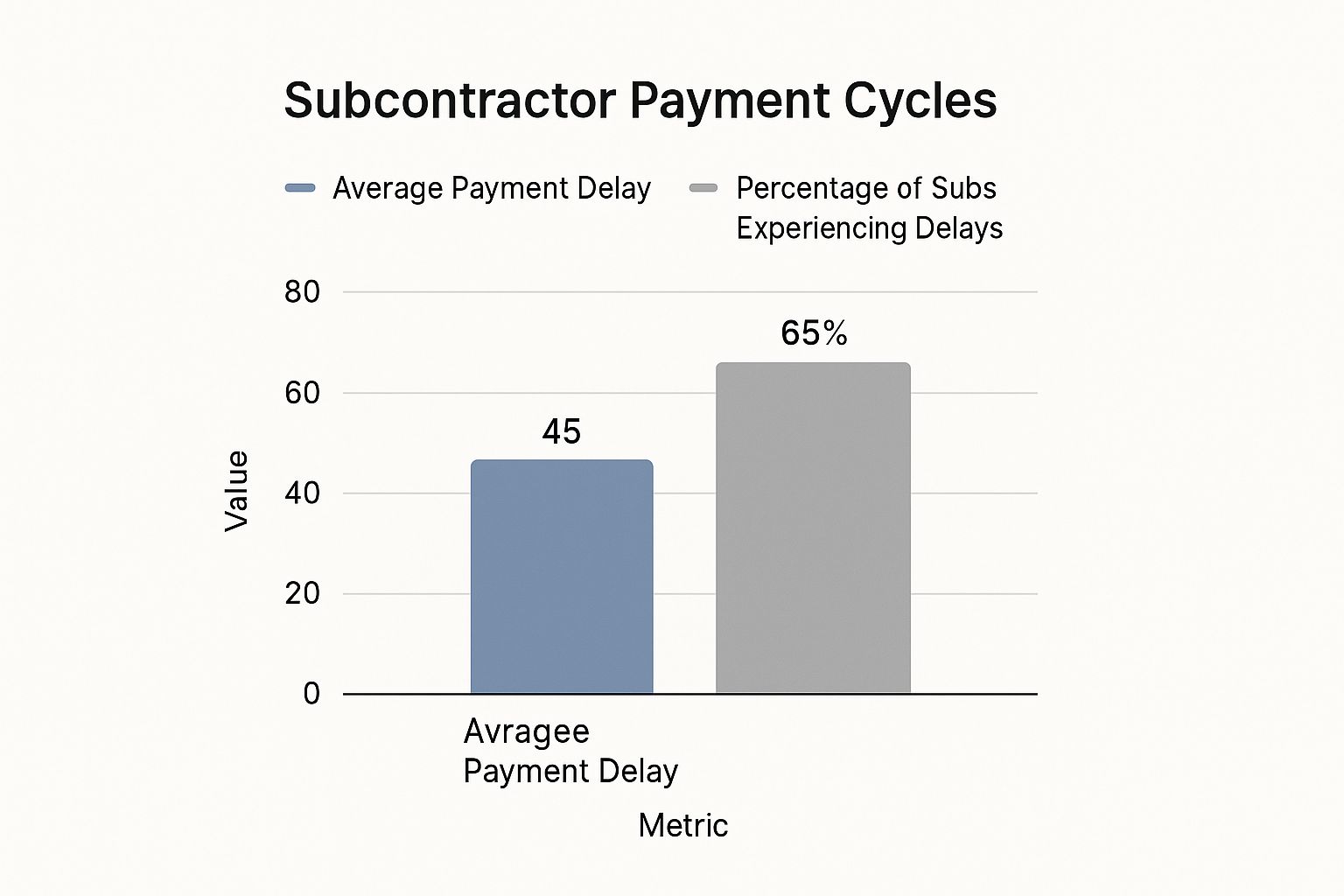General Contractor vs Subcontractor: Key Differences Explained
When you get down to it, the difference between a general contractor and a subcontractor is all about scope. The general contractor is the big-picture boss, the one steering the entire construction project from start to finish. A subcontractor, on the other hand, is a specialist—an expert brought in to handle one specific piece of the puzzle.
Think of it like this: the GC is the head chef of a restaurant, designing the menu and running the entire kitchen. The subcontractors are the master pastry chef, the butcher, and the saucier, each responsible for perfecting their specific craft.
Understanding the Construction Project Hierarchy

Every well-run construction site has a clear chain of command, and it's built for one reason: to keep things moving efficiently. At the very top sits the general contractor (GC). They're hired directly by the property owner and are the single point of contact responsible for turning a blueprint into a building.
The GC’s job is almost entirely managerial. They’re the ones juggling budgets, creating schedules, pulling permits, and making sure the project complies with all regulations. A successful project hinges on a solid team, and the GC is the one who assembles and leads it. It’s worth taking a moment to meet the construction team to see how all these crucial roles fit together.
The Role of Specialization
So, where do subcontractors fit in? They are the experts operating under the GC's direction. These are the independent pros who bring deep knowledge in a single trade—think plumbers, electricians, roofers, or painters. A general contractor doesn't personally hang drywall or wire an outlet; they hire a trusted subcontractor to execute that work flawlessly.
A key distinction to remember: The subcontractor works for the general contractor, not the property owner. This keeps communication streamlined and places the responsibility for scheduling and quality control squarely on the GC's shoulders.
This structure is what makes modern construction possible. You get the benefit of a GC's broad project management oversight combined with the focused, high-quality work of specialized tradespeople.
General Contractor vs Subcontractor At a Glance
For a quick breakdown, it's helpful to see the core differences side-by-side. This table cuts right to the chase.
| Primary Role | Overall project management and oversight | Specialized trade execution (e.g., plumbing, electrical) |
| Hired By | The property owner or client | The General Contractor |
| Scope of Work | Broad; manages the entire project from start to finish | Narrow; focused on completing a specific task or trade |
| Main Responsibility | Final project outcome, budget, and timeline | Quality and completion of their specific craft |
| Point of Contact | Is the single point of contact for the client | Reports directly to the General Contractor |
In short, one orchestrates the entire symphony, while the others are the master musicians playing their individual parts.
Comparing Project Responsibilities and Scope

While their titles sound similar, the day-to-day reality for a general contractor (GC) and a subcontractor couldn't be more different. Think of it like a film director versus a special effects artist. The GC is the director, managing the entire production from a high level, while the subcontractor is the specialist brought in for a specific, crucial scene.
At its core, the construction industry hinges on this hierarchy. General contractors are hired to run the whole show—managing timelines, budgets, and the client relationship. They then hire subcontractors to handle the actual hands-on work. This structure allows top-tier subcontractors to excel by focusing on their specific craft, a dynamic explored in-depth by Small Business Growth Partners.
The General Contractor's Broad Oversight
A GC’s world revolves around logistics, paperwork, and people management. They are the project's big-picture strategist, the one responsible for making sure all the individual pieces come together to form a cohesive, successful whole.
Here's a look at what fills their days:
- Securing Permits and Compliance: The GC is the one who deals with the city, navigating the maze of local building codes to ensure every aspect of the project is above board.
- Creating the Master Schedule: They are the keepers of the timeline, orchestrating when the plumbers start, the electricians finish, and the painters arrive.
- Managing the Budget: From start to finish, the GC is accountable for the project's financial health, tracking every dollar and paying all vendors and subcontractors.
- Site-Wide Safety: Legally, the GC is on the hook for maintaining a safe worksite for everyone, which means creating and enforcing strict safety rules.
Ultimately, the GC serves as the client’s single point of contact. If a homeowner has a question or wants to change a detail, they call the GC, who then translates that request into action for the appropriate team.
A general contractor's primary value isn't in swinging a hammer, but in their ability to manage, coordinate, and take ultimate responsibility for the entire project.
The Subcontractor's Specialized Focus
In the general contractor vs subcontractor matchup, the sub’s role is all about deep expertise in a narrow field. They are the masters of their trade, hired to execute a specific task with skill and precision.
While the GC is spinning a dozen plates at once, the subcontractor is laser-focused on just one.
Let's take a kitchen remodel as an example. The GC is in charge of everything from demolition to the final coat of paint. The subcontractors they hire, however, have very specific jobs:
- The Plumber: Is concerned only with installing the sink, connecting the dishwasher, and making sure the water lines are perfect, all based on the plans.
- The Electrician: Concentrates solely on running wires for new outlets, hanging light fixtures, and ensuring every connection is safe and up to code.
- The Tiler: Spends their time meticulously laying the backsplash and floor tiles, focused entirely on a flawless finish.
Each subcontractor brings their own tools, carries their own insurance, and answers directly to the GC—not the property owner. This system is what allows complex projects, from a simple renovation to comprehensive home building services, to be completed efficiently. You get a dedicated expert for every job, all managed by a single, accountable leader.
How Contracts, Risk, and Payments Differ
At the heart of the difference between a general contractor and a subcontractor is one simple thing: who signs the contract with whom. This single detail determines who carries the weight of the project's success or failure.
A general contractor (GC) signs a single, all-encompassing contract directly with the property owner. This makes them the sole point of legal and financial responsibility for everything that happens on that job site, from start to finish. It’s a classic high-risk, high-reward position.
Think about what that really means. The GC is on the hook for hitting deadlines, managing the budget, enforcing safety protocols, and ensuring every last detail meets quality standards. That includes the work done by every single specialist they bring on board. If something unexpected sends the project over budget, that financial hit usually lands squarely on the GC's shoulders.
The Subcontractor's Place in the Contractual Chain
Subcontractors, on the other hand, operate with a much tighter scope of responsibility. They have no legal agreement with the property owner. Their contract is exclusively with the general contractor who hired them for a specific job.
This creates a very clear chain of command. A subcontractor’s risk is neatly contained within their trade. An electrician is liable for wiring the building correctly and on time, but they aren’t responsible if the drywall crew falls behind schedule. Their legal duty begins and ends with the terms of their agreement with the GC.
The flow of contracts dictates the flow of risk. The GC takes on total project liability from the owner, then passes down smaller, highly specific slices of that risk to individual subcontractors.
Following the Money—And the Friction
This contractual hierarchy also sets up the payment chain, which is notorious for being a major point of friction in the construction world. The property owner pays the GC according to the project schedule, and the GC then pays the subcontractors out of those funds for their completed work.
This tiered system can put a serious financial squeeze on subcontractors. They often have to front the costs for their own materials and labor, then wait to get paid by the GC. Managing cash flow becomes a constant battle for survival.
And delays are, unfortunately, the norm. A National Subcontractor Market Report revealed that 71% of subcontractors are consistently worried about cash flow. While GCs often get paid by owners within 30 days, subcontractors report waiting an average of 56 days for their payment. This gap forces many smaller, specialized firms to operate on razor-thin margins, constantly juggling bills while they wait for checks to clear. You can dig into the full research about these payment cycle disparities to see just how deep the financial pressure runs.
How Costs and Markups Impact Your Project Budget
Figuring out the cost structure is one of the most critical parts of planning your project. When you hire a general contractor (GC), you're not just paying for their time on site; you're paying for them to own the entire process. Their fee, which is a markup on the total project cost, reflects that massive responsibility.
Think of this markup as the GC's cost of doing business. It covers their overhead—things like insurance, office staff, and equipment—and allows them to make a profit. You’re essentially paying a premium for a single point of contact who manages risk, coordinates all the moving parts, and takes the heat if things go wrong. In my experience, that fee often prevents far more expensive mistakes down the road.
Breaking Down General Contractor Fees
A GC's pricing is all about their role as the project manager. Typically, you'll see a markup of 10% to 20% on the total cost of the project. This is their fee for overhead and profit.
On top of that, when they bring in subcontractors for specialized trades, GCs usually add another 15% to 20% markup to what the subs charge. For particularly tricky or high-end work, that number can climb even higher. If you want to dive deeper into the numbers, the Contractor Growth Network has a great breakdown of how these markups affect the final price tag.
This layered cost is why hiring a GC can feel more expensive at first glance. If you just need a room painted, hiring a painter directly is a no-brainer—you avoid the extra fee. But for something like a full kitchen gut, where you need a plumber, electrician, cabinet installer, and tiler, that GC fee is buying you something invaluable: orchestration. They make sure the plumber isn't holding up the cabinet guy, ensuring the whole thing runs smoothly.
The Subcontractor Cost Structure
Subcontractors have a much more direct pricing model. They submit a bid to the GC that covers their specific job—and only their job. That price includes their labor, materials, overhead, and profit, but it’s all self-contained.
While their model is simpler, it also leaves them more exposed. They're at the bottom of the payment chain and often face serious financial pressure, especially when it comes to getting paid on time by the GC.

This data really drives home the cash flow nightmare many subs live with. It’s not uncommon for them to wait weeks, or even months, to get paid for work they’ve already completed and fronted the costs for.
Key Takeaway: A general contractor's markup isn't just an extra cost; it's an investment in project management, quality control, and peace of mind. While you can save a few bucks by hiring subcontractors directly for simple jobs, the GC's fee provides critical value on complex projects by preventing costly mistakes and ensuring everything gets done right, and in the right order. The real question isn't about cost, but whether your project's complexity justifies paying for that expert oversight.
Choosing the Right Professional for Your Project

When it comes to the general contractor vs. subcontractor debate, making the right call hinges on one thing: the complexity of your project. This single decision can make or break your budget, your timeline, and honestly, your sanity.
For any large-scale project—we're talking a full home addition, a down-to-the-studs kitchen remodel, or anything that requires a stack of permits—a general contractor (GC) isn't just a good idea; they're essential. Think of them as the captain of the ship, your single point of contact who shields you from the chaos of coordinating multiple specialists.
On the other hand, if you're dealing with a small, self-contained task, hiring a subcontractor directly is almost always the more cost-effective move. Need a leaky pipe fixed or a single room painted? There's no sense in paying a GC's management fee for oversight you simply don't need.
When to Hire a General Contractor
A GC earns their keep when a project has a lot of moving parts. Their real value is in their ability to orchestrate the entire process, manage risk, and make sure every nail is hammered according to code. You absolutely need a general contractor on your team if the job involves:
- Multiple Trades: If your project requires a plumber, an electrician, a drywall expert, and a painter, the GC is the one who lines them all up so they aren't tripping over each other, preventing expensive delays.
- Permits and Inspections: Experienced GCs have working relationships with local building departments. They know the people, the paperwork, and the process, which saves you countless headaches.
- A Long Timeline: For any job stretching over weeks or months, a GC provides the steady hand and consistent oversight needed to keep the project moving forward.
- Structural Changes: Any work that touches load-bearing walls or changes the footprint of your home is serious business. It demands a GC's expertise and, crucially, their liability coverage.
If you’re leaning this way, it’s worth reading up on how to hire a general contractor to make sure you find someone who truly understands your vision.
When to Hire a Subcontractor Directly
Going directly to a sub is a great move when you're comfortable managing the job yourself. Just remember, when you hire the specialist, you become the project manager.
By hiring a subcontractor directly, you effectively take on the GC's responsibilities on a micro-scale. This includes scheduling the work, supplying any necessary information, and verifying the quality of the finished product.
This approach is perfect for:
- Single-Trade Jobs: Think tasks like swapping out a water heater, painting a bedroom, or having a new light fixture installed.
- Clear and Limited Scope: The work has a well-defined start and end, with no dependencies on other tradespeople.
- Low Risk: The potential for a major disaster is minimal, and you don't need to navigate a maze of complex permits.
In the end, choosing the right pro is about protecting your investment. For any significant project, finding the right home remodel contractor near me is the critical first step to getting the job done right.
Common Questions About Contractors and Subcontractors
When you're trying to figure out who to hire for a project, it’s easy to get tangled up in the terminology. Who does what? When do you need one over the other? Let's clear up some of the most common questions people have about general contractors and subcontractors.
Can a Subcontractor Work Directly for a Homeowner?
Absolutely. A subcontractor can work directly with a homeowner, but it's important to understand what that means for you. When you hire a sub directly, you're essentially taking on the role of the general contractor.
This setup is perfect for small, focused jobs. Think hiring a plumber to fix a leaky faucet or an electrician to install a new light fixture. For bigger projects, however, you'll be the one responsible for scheduling all the different trades, making sure the quality is up to par, and taking on all the liability.
Is It Cheaper to Hire Subcontractors Myself?
If you only need one specific task done, then yes, it's almost always cheaper to hire a subcontractor directly. You're cutting out the middleman and avoiding the general contractor's markup.
But for a multi-layered project like a full kitchen remodel, trying to juggle multiple subcontractors can quickly become a false economy. A good GC prevents expensive scheduling conflicts and coordination headaches that can easily blow your budget.
The general contractor’s fee often pays for itself through efficiency, access to trade discounts, and crucial risk management, providing significant value on complex jobs.
What Insurance Should Both Professionals Carry?
Both general contractors and their subs need to have two non-negotiable types of insurance. The first is General Liability insurance, which covers things like accidental property damage. The second is Workers' Compensation, which is there to protect their crew if anyone gets hurt on your property.
Before a single hammer swings, always ask to see a current certificate of insurance. This is your proof that their coverage is active. As you get ready to hire, it's also a great idea to have a list of crucial questions to ask a general contractor to make sure you’ve found the right professional for your job.

